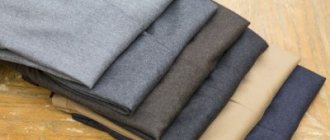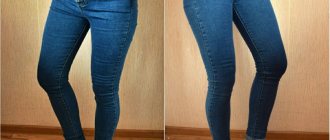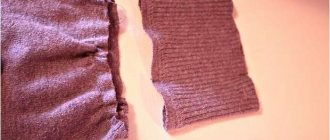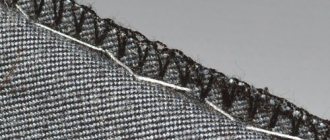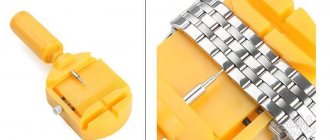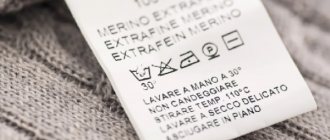Denim trousers have gained popularity for their practicality. This is a dense, strong fabric, which consists of an interweaving of 2 types of threads. The fabric is based on a matrix of cotton fiber with different thread thicknesses (depending on the type of denim).
To make the fabric softer and more comfortable for daily use. a certain percentage of viscose, lycra or artificial elastin is added to it. When buying jeans, you need to adjust the length to the buyer’s height and body shape. You can shorten your jeans yourself without cutting off the bottom of your trousers.
Material and tools
Having only trousers, it is pointless to start hemming - you need to prepare a complete set of tools and auxiliary material, depending on the chosen method:
- white threads and pins for primary fixation;
- plain threads for classic models, or material of a different color for jeans;
- needles;
- sewing machine, if we choose mechanical hemming;
- trouser braid;
- chalk or soap;
- adhesive tape (web) when choosing the appropriate method.
Fold without trimming
It is advisable to fold children's trousers without cutting the length. If you simply make a large allowance for the seam, bend it to the required length and sew it up, during wear the edge will fray slightly, so that after a year, if you tear off and press the trouser legs, there will be a noticeable strip at the height of the old hem allowance.
To avoid this, make a “denim” hem:
- After putting the trousers on the child, mark the desired length of the new item on the front side.
- Measure the height of the excess.
- The resulting value is set aside from the original hem seam and a line is drawn.
- Fold the trouser legs so that the branded stitching and the marked line are aligned.
- Baste or pin with pins.
- Stitch by hand or on a machine, departing 0.1-0.2 cm from the branded stitch.
- They straighten their trousers.
- From the inside or from the face, iron the seam through gauze so that the seam allowance goes up. There is no need to steam the allowance itself - otherwise it will press through the fabric and leave an unsightly strip on the front side, especially noticeable on shiny trousers.
Preparation and first recommendations
Any repair and tailoring of clothes begins with fitting - only the thing that fits your figure looks perfect and improves your appearance.
Video tips for beginners on hemming pants
A few tips to properly hem men's trousers:
- Having put on trousers, choose shoes that match them;
- use the belt;
- classic models should reach the middle of the heel;
- narrowed models can be located a couple of centimeters higher;
- Fold the legs and pin them, or sew a few stitches with white thread.
Now take off your pants and lay them on the table. Draw the first line along the fold line - this is the future level of the length of the trousers. Now put about 3-4 cm down for the hem. A large length will spoil the appearance and is used exclusively for children's models.
What length should the trousers be?
The length of the pants directly depends on the width of the product styles. There is a classic rule to remember: tapered pants should be shorter and flared ones should be longer.
Circumcision process
Women's trousers length
According to the laws of etiquette, women's pants should reach the heel. It looks gentle, beautiful and visually the legs become longer. This length would be considered traditional, but in recent days there are a lot of new styles appearing, so it is difficult to say about a single correct length of trousers. Such standards are no longer suitable for bell-bottom trousers.
Bottoms in denim pants
Correct trouser length for different models:
- Direct. Length reaches ½ heel. Visually, the legs look longer and slimmer. This also applies to jeans;
- Pipes. Styles with a loose fit from the hip point. Pants that are too short will visually make your hips appear fuller. With a good cut, almost the entire heel is not visible, but the toe should stick out. The correct distance from the ground is 2 cm;
- With arrows. The style is suitable for the office, straight, reaching to the middle of the heel, with smooth arrows on both sides;
- Sports. If you choose correctly, you will feel comfortable and soft when playing sports. If the trousers have an elastic band, then the ankle should not be visible.
Options for the correct length of pants
Sweatpants have their own nuances. Since the pants are knitted, it is not always possible to do this by hand. Tailors use special machines for this, but at home it can be done using a regular overlocker.
To prevent the fabric from puffing up, craftsmen suggest using needles with slightly rounded ends. To make the material stretch better, it is advisable to place a thin strip of paper. Process of working with sweatpants:
- Measure the material for bending and cut it;
- Go over the edges with an overlocker;
- Fix the bends;
- Sew from the inside.
Next, you need to make another seam at a distance of 4 mm. If the zipper is on the side, then it needs to be opened, making 5 cm on the bend.
Women's pants with stripes
Pants with stripes are hemmed in the place where the decorative seam is located. The same is permitted if the product has an elastic band.
Important! The main disadvantage of knitwear is that it quickly stretches under the influence of mechanical factors. To avoid this, it is advisable to use a special foot to carefully advance the material during work. New styles of sewing machines have an additional stitch for such fabric.
You may be interested in this: Patterning and sewing beautiful clothes for small dogs
Men's trouser length
When buying pants, you need to try on as many models as possible. Since it is very difficult to find the right one the first time. Sometimes stores offer a service for adjusting pants on the spot. It is advisable to wear the shoes that you plan to wear with trousers.
Classic men's trousers and oxfords
Note! It doesn’t matter what kind of pants you buy, the main thing is that they fit well and match the shoes.
For formal events, it is better not to wear short styles, such as slacks, joggers, and chinos. They will be tapered to the ankle, suitable for everyday wear. For celebrations, it is better to wear classic trousers and oxfords.
Technique for hemming trousers
Methods using tape and blind stitching are described in the relevant articles, which are linked below, but here we will touch on the simplest hemming using a sewing machine.
After fitting and marking, we trim off the excess fabric. The resulting edge should be overcast with an overlocker - this way it deteriorates less and retains a pleasant appearance.
Now, more about the stages of hemming pants:
- First of all, we sweep the trouser braid along the level of the hem of the trousers;
- the stitching is carried out along special textured stripes around the entire circumference;
- when you go through the entire circle and approach the overlap of the ends, you should lower the needle and raise the foot of the sewing machine;
- Sew a seam across the tape and proceed to stitching the other edge of the tape;
- now iron the trouser tape;
- we bend the trouser leg and stitch it with suitable threads, or manually sew a blind seam;
- iron the seams and enjoy the excellent trousers.
How to shorten trousers without web sewing
Cobwebs cannot be used for all types of material. For example, it is not advisable to use it when hemming knitted pants, since the materials are very elastic and can lose their extensibility with cobwebs. It is also better not to use cobwebs on thin materials. It can thicken the product, creating extra volume. As for expensive materials, it is better to entrust the work of hemming things to a specialist.
Other types of fabrics can be easily processed using gossamer.
Attention! One of the big benefits of using duct tape is that there will be no visible threads on the outside of your pants.
Execution order:
- Turn the trouser legs inside out;
- Bend to the required length;
- Place a piece of cobweb between the fold and the leg;
- Use a hot iron from the inside out.
If the web is of poor quality, then it will not glue the place together. Therefore, you will need to use adhesive tape and spray water on it.
In stores there is tape that is applied to a paper base. This type of web has a number of advantages compared to the classic one. The fact is that it is quite difficult to place it so that it ends up in the right place. It is much easier to do this if it has a paper base.
Ribbons are inserted into the fold and ironed several times at high temperature. Therefore, you need to heat the iron very hot. The tape melts well and glues the fabric.
Tips for use:
- Practical application proves that the tape can peel off after three washes. In this case, it needs to be glued again. Therefore, you should try not to pollute things;
- When washing, the water temperature should not be more than 50 degrees;
- Sometimes during operation, the cobweb sticks to the iron. Here you need a small piece of fabric soaked in alcohol. It removes tape residue well. To avoid staining the iron, it is advisable to cover it with a bandage or cotton cloth.
Quick repair - hemming trousers with tape
Most often, ready-made models of trousers from stores and boutiques have a slightly higher length, which has a number of inconveniences:
- spoils the view - the trouser leg, dragging on the ground, turns away the eyes;
- premature wear of the material;
- does not match the style.
The problem of long trousers can be easily solved - you need to shorten the trousers and the easiest way is to use adhesive tape.
Video of using trouser braid - cobwebs
Materials and tools for hemming trousers with tape
If you decide to repair new trousers yourself, rather than using the services of a workshop, then in addition to the trousers themselves you will need:
- adhesive tape - cobweb;
- threads matching the style and color of the trousers;
- white threads for basting;
- tailor's scissors;
- ruler, meter;
- soap or chalk;
- sewing machine, needles.
Most of the sewing equipment is constantly available to any housewife; missing items and tools can be easily purchased at any fabric and accessories store.
Some tips
- Since some materials tend to shrink after washing, it is recommended to wash the item before starting work to avoid unpleasant consequences.
- If you are working with jeans, you should leave a margin of about one centimeter.
- For summer trousers, braid is used only on the back side, and the allowance is less than a centimeter.
- Soap marks are easier to get rid of than chalk marks.
- If sewing is urgent, you can use double-sided interlining. It is worth understanding that this solution is temporary. However, to use it, you need to apply the tape to the work area - fold it and steam it on one side. Next, fold the other edge and do the same on the other side.
- For knitwear and jeans, you can use special needles and threads.
- If the needle is already rusty, it should be replaced.
- For products made from fabric that has decorative elements, you can shorten it at your own seams.
- After the marks are applied, it is better to cut off the pants on a flat surface.
- Make sure that the seams are not visible.
- In order for classic trousers to look as decent as possible, the back of the legs should be slightly longer than the front, which covers only 2/3 of the shoe.
- If you choose the right length, the trouser leg gathers at the shin into a fold.
Women's vest pattern
How to fix a hole in a down jacket
When is it better to redraw
Recutting is needed when the trousers require not a superficial correction, but a complete alteration. That is. If they need to be changed several sizes, change the shape and fit. In fact, this process involves ripping out old trousers and sewing new ones.
Re-cutting requires at least minimal skills in cutting and sewing, otherwise it is unlikely that you will get a good product. If you have no experience, then it is recommended to contact a specialist or train on pants that you don’t mind ruining. All skills come with experience.
First, the old trousers need to be completely ripped apart. This is done at the seams; it is better not to use scissors, but to use a special tool - a ripper.
Then you need to remove all the threads, iron the seams and mark new ones. The second option is to use a pattern that will be used to sew new trousers from the old material. Making a pattern is not easy for a novice craftsman, so it is better to use a ready-made one (download from the Internet).
Reshaping
The article discusses how to sew pants a size smaller and recut them if you need to significantly change the size of the item. In fact, there is nothing complicated and even a beginner who has never sewed can cope with the task. It is important not to forget about the well-known proverb “measure twice, cut once.”
Reducing the waist
There are several ways to sew trousers in the waistband: insert darts or cut off the excess with scissors along the side seams or along the step cut. The first method is good for light and medium fabrics, and it is better to adjust jeans at the seams. Reducing the sides is suitable if you are going to alter a man's trousers. There are practically no darts made on them.
Correcting the middle seam
Reducing the step cut (located at the back, in the center) is the best solution if your figure has a large difference between the waist and buttocks. The operation is simple; the only thing that can complicate things is the belt loops, which will need to be moved.
- Open the waistband stitching by 10-12 cm and step the cut to the hips or below. Open the belt loops if there are any.
- Mark a new center seam line with chalk, adding an inch on each side for the seam allowance.
- Place a line. Try it on and make changes if necessary.
- Cut the belt in half and reduce it to the new size.
- Move the belt loops to a new distance, and then sew them in the same way as the rest.
Don't cut the fabric without making sure you leave an allowance. It is better to first lay a new line, and then cut off the excess, so that there is still an opportunity to fix everything.
We correct only on the sides
The operation is similar to the method described above with the difference that now we are making adjustments only on the sides.
- Unfasten the waistband at the sides and spread the product out to the sides by 20-23 cm.
- Mark new lines, hand baste and try on.
- Sew stitches on a sewing machine.
- Reattach the waistband the same way it was finished.
Reduce with darts
You can reduce the waistband of your pants by adding darts. They are placed on both sides, at a distance of approximately 10 centimeters from the center. Darts are useful if the fastening is located on the side. This method is often used to sew in women's trousers.
- Decide where you will place the darts. Undo the belt in all these areas: you will have to rip it off almost completely, leaving only the clasp intact.
- Try it on and fold in excess fabric and pin it.
- Baste by hand and then stitch by machine.
- Iron the darts, placing them mirror-like from the center line.
- Cut the belt, remove the excess length and stitch again.
- Sew it to the waist.
Creative hem
Youth and children's jeans are hemmed using finishing elements:
- Various materials are used as finishing and simply to lengthen the jeans: genuine leather, denim of a different color.
- The stitching seam of an extension extension made of another material can be decorated with your own embroidery.
- You can form cuff cuffs from plaid fabric and use colored fabric for the pocket edging.
A carefully executed hem, while maintaining the hemmed edge, allows you to perfectly fit expensive jeans, while a creative hem gives a second life to your favorite pair, and is liked by your family and those around you. A simple job of repairing and adjusting jeans can lead to a future sewing hobby.
How to cut jeans while maintaining the factory hem seam
It is necessary to preserve the finishing stitch when the denim fabric has a special treatment. Or in the case when the new seam does not match the finishing decorative stitches of the jeans. In all other cases, it is better to hem as expected.
Trimming jeans while maintaining the factory hem seam is fairly easy. The main thing is to calculate exactly how many centimeters to shorten the jeans, take into account the seam allowances (1.5 cm) and carefully, close to the line of the factory seam, first sweep and then sew the cut off areas on the wrong side.
The photo clearly shows how to hem jeans while maintaining the factory seam. After joining, the cut edges of the jeans must be processed with an overlock, zigzag, or hand-stitched.
Video on how to make shorts from old jeans.
Finishing
After shortening, the clothes should be washed and ironed. Before performing these manipulations, you must fasten the zipper on your trousers, as well as all buttons without exception. It is recommended to give preference to detergents intended for delicate items.
If washing is done by hand, you can additionally use a brush. It will act as an additional tool. Powder or regular soap is applied to it, after which the entire surface is thoroughly wiped. Particular attention is paid to the hemmed part. It is strongly not recommended to wring out clothes after this. The water should drain from it naturally.
Ironing after shortening should begin from the pocket area . Then you need to go over the waist with the iron. With its help, you need to carefully straighten all the folds. To form the arrows, the top and inner seams of the product are combined. The surface of the iron moves as smoothly as possible. This way it is possible to avoid the appearance of unevenness and folds. When processing a fold line, be sure to turn on the steaming function.
Often the arrows disappear very quickly. In order to preserve them for as long as possible, you can use one trick. Before ironing, you just need to rub the fabric with soap.
On light-colored items, the iron often leaves scorch marks, which significantly spoil the appearance. To avoid their appearance, we recommend ironing through thin fabric folded in layers. In this case, gauze should not be used. It has a heterogeneous structure and unevenness may appear on clothes.
To shorten a piece of clothing, it is not at all necessary to contact an experienced craftsman. It’s quite possible to do these steps yourself, even at home. You just need to accurately determine the appropriate length and prepare everything that will be useful in your work. If you strictly follow the instructions, the trousers will turn out beautiful and fit perfectly.
Which jeans look fashionable with a cropped hem?
Any pair of jeans can become a fashion accessory if you follow a few simple cutting rules. The table shows the main types of jeans and options for transforming them by shortening the length.
| Jeans type | Type of transformation |
| Flared |
|
| Direct |
|
| Tapered |
|
Achieving a stylish casual effect when cutting jeans depends on the type of fabric they are made from.
You can create a beautiful fringe only from natural rough denim that does not have elastane (or its content is less than 50%). Stretch jeans will look great with the stitching still in place or with a raw hem that has a slightly fluffy, casual look.
More often, to transform jeans, they choose plain models in classic colors (black, blue, light blue). Fringe and various slits on colorful jeans will not look expressive. At the same time, following the trend of the season, jeans with small prints, having a raw hem and contrasting details, are becoming popular.
Preparatory manipulations
Before you fold the bottom of your trousers, you should prepare for this process. As already mentioned, the length is determined taking into account the model of the pants. It is most convenient to carry out such manipulations with an assistant. One person tries on clothes, while the other notes the desired height. You can also use an already hemmed product for this purpose. In order to avoid making mistakes, you need to follow simple instructions.
Purchased clothing is turned inside out. The same manipulations should be done with old pants. These products need to be folded so that the crotch seams touch. After this, the cutting line is marked.
Now you need to draw a right angle from the arrow and draw a horizontal line on both legs.
All that remains is to build the allowance line that is needed for the hem. Another line is drawn at this point. It should be approximately 3 cm below the first.
It is most convenient to mark all the lines on the material with an ordinary soap. Before cutting off the intended element, it is recommended to pin the trouser legs together with pins. This prevents the hem from shifting. Perform similar manipulations in turn with each trouser leg. As a rule, experienced needlewomen resort to this method, but novice craftswomen can also use it.
Instructions for hemming while maintaining the factory seam
An integral element of clothing is a decorative seam. Many people, having bought jeans that fit them perfectly at the waist, but are not the right length, wonder how to maintain the factory finish.
To do this, you need to adhere to the following procedure:
- determine the length and width of the hem on the wrong side;
- Unfold the item and straighten out all the folds;
- From the intended length, measure upward the width of the hem;
- draw a line parallel to the floor and put 1 centimeter down;
- draw a second line and perform all of the above steps on the other leg;
- cut along the second line;
- take a scrap with a factory stitch and set aside 1 cm from the hem;
- draw lines and cut off excess.
Hemming jeans while maintaining the factory seam
Hemming jeans while maintaining the seam should be done as follows:
- attach details with trim to the trousers;
- align the cuts and chip inside and on the sides;
- carefully sweep away the parts;
- stitch from the factory seam to 1 mm;
- make cutting allowances to the line a few millimeters;
- trim the bottom allowance to 4 mm;
- Iron the edges to the hem;
- Apply a stitch 1 mm from the factory seam and overcast the allowances.
In this simple way you can hem jeans while maintaining the factory seam.
